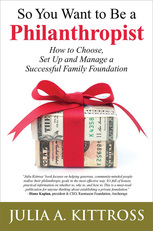 It's never too soon to introduce caring about others and the community. Your kids will imitate your actions so let them see you engage. It takes time, but it is quite simple. As you go about your charitable and community building activities, bring the kids along. At a certain age, they can be plopped at the back of a board room with crayons or an iPad. They won't hear or understand much (or anything) that is going on, but they will recall that their parents find it important to be involved in community activities. As children get older and you decide they're ready to receive an allowance, require that they divide their allowance into two or three pots: to spend, to save... and to donate. You can simply give your child three jelly jars or purchase items designed for this purpose, such as Moon jars. Then, once a year, ask your children what they care about — animals, children who need health care, people who need housing — and help them donate the money. Make it a family event to volunteer — collecting tickets at the PTA carnival, serving a meal at the homeless teen center, participating in clean-up day at the local park or beach. Volunteering as a family reinforces shared values. When you think the time is right, provide a small amount — $100 - $500 — to your children and have them work together to determine where it should be donated. (A good way to learn how to make decisions — and compromises.) You can even ask fellow foundation trustees, other family members or good family friends to serve as philanthropic mentors to your kids. There are some formal youth philanthropy programs where teens serve on grantmaking boards. Youth Philanthropy Connect is a national organization. Community foundations and Social Venture Partners are two places to look locally for these (the links lead to examples in Seattle), or go to Learning to Give for other ideas. —Julia
0 Comments
 "I’ve always said that when it comes to influencing your children to be charitable, it’s not what you say, it’s what you do. Guess what? I was wrong." Ellen Remmer of The Philanthropic Initiative just posted this statement above on TPI's blog, Deep Impact. Like Ellen, I've spent years suggesting to clients concerned about their children's philanthropic urges that they should teach by doing. I still think that's a good idea -- I know how my mother's philanthropic activities affected me, even as I sat at the back of the room coloring while she participated in meetings -- but the Women Give 2013 study Ellen sites is fascinating. Ellen wrote: "it found that children whose parents to talk to them about giving are 20% more likely to give than those whose parents don't. And it found that talking actually matters more than role-modeling when it comes to parents influencing their children’s philanthropic behavior." Well, show and tell, I guess! —Julia  By mid-September 2013, So You Want to Be a Philanthropist will be available on Amazon. This lively, jam-packed book will allow those thinking about setting up a family foundation to ask the questions they should — before they do. And for those with a foundation that isn't functioning as they'd hoped, this book can help get you back on the right track. I'm excited about your reactions and look forward to hearing what you think! — Julia |
AuthorJulia Kittross: Archives
September 2017
Categories
All
|

Julia Kittross | Philanthropy Sherpas
[email protected] | www.PhilanthropySherpas.com | 206.334.7995
[email protected] | www.PhilanthropySherpas.com | 206.334.7995
 RSS Feed
RSS Feed